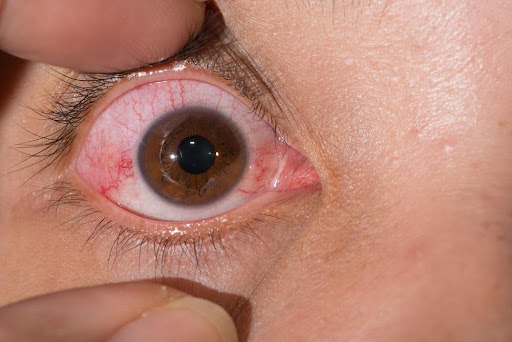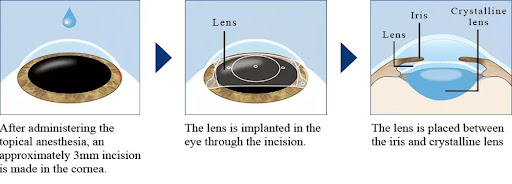Uncover the mysteries of scleritis with our comprehensive guide. Learn about symptoms, treatments, and expert insights from one of South Korea’s leading eye centers, Eyeonce Eye Clinic, to manage this eye condition effectively.
What is Scleritis?
Scleritis is characterized by inflammation of the sclera, the outer layer of the eye commonly referred to as the “white” of the eye. This inflammatory disorder extends beyond the surface, affecting more profound layers of the eye and leading to a range of symptoms, from discomfort to severe pain, redness, light sensitivity, and potential vision impairment.
There are two types of scleritis, each presenting unique characteristics and challenges:
Anterior Scleritis
- Anterior scleritis involves the inflammation toward the front of the eye, affecting the sclera portion closest to the cornea.
- There are three subtypes of anterior scleritis—diffuse, nodular, and necrotizing. Each subtype varies in severity and the extent of tissue involvement.
- Individuals with anterior scleritis may experience intense pain, redness, light sensitivity, and blurred vision. The severity of symptoms often prompts early medical attention.
Posterior Scleritis
- Posterior scleritis affects the back of the eye, involving the sclera toward the optic nerve.
- While it shares some symptoms with anterior scleritis, posterior scleritis may also present with additional indicators like swelling and distortion of the retina. Pain in posterior scleritis is typically less severe than in the anterior form.
- Diagnosing posterior scleritis can be more complex due to its subtler symptoms and potential overlap with other eye conditions. Advanced imaging techniques are often employed for accurate diagnosis.
Understanding the differences between anterior and posterior scleritis is essential for effective management, emphasizing the significance of seeking professional guidance from a trusted eye center like Eyeonce Eye Clinic. Their eye specialists, Dr. Paik Dong Won and Jung Sae Rom, are experts in navigating the complexities of scleritis. Seeking their guidance ensures accurate diagnoses and a personalized approach to scleritis management, promoting optimal ocular health.
What causes scleritis?
While the exact cause of scleritis is not always straightforward, several factors contribute to its development, often involving the body’s immune system.
- Autoimmune Disorders – One of the significant contributors to scleritis is its association with autoimmune disorders. Conditions such as rheumatoid arthritis, lupus, and vasculitis can trigger an immune response that mistakenly attacks the sclera, leading to inflammation.
- Infections – Infections, although less common, can also be culprits. Bacterial, viral, or fungal infections may incite an inflammatory response in the sclera, resulting in scleritis.
- Underlying Health Issues – Scleritis is occasionally linked to underlying health problems, including certain inflammatory conditions like gout or conditions affecting the blood vessels. Managing these underlying issues can be crucial in addressing scleritis.
- Environmental Factors – Environmental factors, such as exposure to irritants or allergens, can sometimes trigger scleritis. Understanding and mitigating these environmental influences can be beneficial in managing the condition.
- Genetic predisposition – While less common, a genetic predisposition may contribute to an individual’s susceptibility to scleritis. A family history of autoimmune disorders or ocular conditions may increase the likelihood of developing scleritis.
Seek prompt medical attention and thorough diagnostics from trusted eye doctors like Dr. Paik Dong Won and Jung Sae Rom better to understand the causes and treatment of your scleritis.
Signs and Symptoms
Scleritis manifests through a spectrum of symptoms, often indicating inflammation of the sclera—the eye’s protective outer layer. Here is a comprehensive overview.
- Intense Eye Pain – Scleritis is frequently accompanied by severe, throbbing eye pain. The pain is often deep-seated and can extend to the forehead and face.
- Redness – Redness of the eyes, particularly in the affected area. The redness may be localized or diffuse, reflecting the extent of scleral inflammation.
- Light Sensitivity (Photophobia) – Increased sensitivity to light. Individuals with scleritis may find bright lights uncomfortable and prefer dimly lit environments.
- Blurred Vision – Impaired vision is a common symptom. Blurred vision may result from inflammation affecting the normal functioning of the eye.
- Tearing – Excessive tearing or watery eyes. Tear production may increase as a response to the inflammation.
- Foreign Body Sensation – A feeling of having something in the eye. The sensation can be persistent and is not alleviated by rinsing the eye.
- Eye Discharge – Discharge from the affected eye. The discharge may vary in consistency, ranging from watery to thick mucus.
- Decreased Visual Acuity – Reduced clarity of vision. Scleritis can impact visual acuity, affecting the ability to see clearly.
It is important to note that the severity of symptoms can vary, and individuals may experience a combination of these indicators. If you or someone you know exhibits persistent eye pain, redness, or any of the mentioned symptoms, seek prompt medical attention at Eyeonce Eye Clinic; they offer personalized diagnosis and intervention effective to treat and prevent potential complications due to scleritis.
Risks of Untreated Scleritis
Leaving scleritis untreated can lead to a cascade of complications such as:
- Vision Impairment – In severe cases, prolonged inflammation may heighten the risk of permanent vision loss and, in extreme situations, blindness.
- Ocular Complications – Complications may trigger secondary ocular complications, including uveitis, glaucoma, or retinal detachment.
- Chronic Pain and Discomfort – Chronic pain can significantly impact an individual’s quality of life, affecting daily activities and overall well-being.
- Systemic Impact – Neglecting scleritis can have broader implications on overall health, emphasizing the interconnectedness of eye health and systemic well-being.
- Surgical Interventions – Surgical procedures have inherent risks, underscoring the importance of early, non-invasive interventions.
- Impact on Daily Functioning – Untreated scleritis can limit an individual’s ability to perform daily activities, affecting independence and productivity.
To mitigate these risks, seeking immediate medical attention upon noticing symptoms of scleritis is crucial. Book a consultation with Dr. Paik Dong Won and Dr. Jung Sae Rom today!
Scleritis Treatment
Addressing scleritis involves a multifaceted approach tailored to the specific characteristics and severity of the condition. Here is an overview of common treatment strategies:
- Anti-Inflammatory Medications – Topical or systemic corticosteroids are often prescribed to reduce inflammation and alleviate symptoms. These medications work by suppressing the immune response, causing scleral inflammation.
- Immunosuppressive Drugs – In cases of persistent or severe scleritis, immunosuppressive drugs may be recommended to modulate the immune system and prevent ongoing inflammation.
- Pain Management – Over-the-counter or prescription pain relievers may be recommended to manage the intense eye pain associated with scleritis.
- Protective Eyewear – Light sensitivity is a common symptom. Wearing sunglasses with UV protection helps shield the eyes from bright light and reduces discomfort.
- Cool Compresses – Applying cool compresses to the eyes can help alleviate the redness and reduce pain associated with scleritis.
- Lifestyle Modifications – Stress can exacerbate autoimmune conditions. Implementing stress-reduction techniques like meditation or yoga may complement medical treatment.
- Surgical Interventions – In cases of complications or advanced scleritis, surgical interventions may be considered. Procedures such as scleral grafts or amniotic membrane transplantation aim to restore ocular integrity.
- Management of Underlying Conditions – Addressing and managing underlying autoimmune conditions is crucial for long-term scleritis.
Every treatment plan at Eyeonce Eye Clinic is tailored to every patient’s unique needs. Effective communication with healthcare providers, adherence to prescribed medications, and regular follow-ups contribute to successful scleritis management, fostering optimal ocular health
Why choose Eyeonce Eye Clinic Gangnam for scleritis treatment?
Utmost Patient Care
Our eye care professionals and staff ensure to give you your money’s worth. We guarantee you receive the best medication possible and assure you that you are guided and understood, making you feel comfortable and confident at every step.
Comprehensive Consultation
Eyeonce Eye Clinic offers comprehensive eye examinations to evaluate your condition and determine the best eye strain treatment. Our ophthalmologists take their time to cater to your questions and address your concerns, ensuring you make an informed decision about our vision correction options.
Expert Eye Doctors
Our ophthalmologists, Head Director Dr. Paik Dong Won and Medical Director Dr. Jung Sae Rom, are highly knowledgeable and adept in treating eye strain. They always use the latest techniques and technologies to ensure optimal results.
Frequently Asked Questions (FAQs)
No. Scleritis is not contagious. It is an inflammatory condition and is not transmitted through contact.
While scleritis can lead to vision impairment, timely intervention, and proper management often prevent permanent vision loss.
Diagnosis involves a comprehensive eye examination, including assessing symptoms, imaging studies, and sometimes, blood tests to identify underlying causes.
Conclusion
Understanding scleritis is highly important to navigate scleritis properly. From recognizing symptoms to exploring treatment options, this journey demands awareness and expertise. Scleritis, with its potential complexities, underscores the need for prompt medical attention and specialized care. Take the first step toward comprehensive eye care, and let your ocular health journey be one of resilience, knowledge, and proactive well-being. Book a consultation now!



